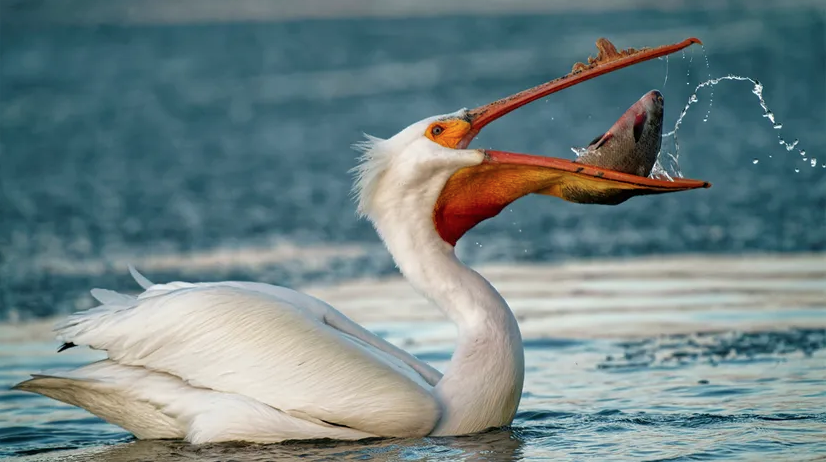
A wonderful bird is the pelican,
His bill will hold more than his belly can.
He can take in his beak,Food enough for a week,But I’m damned if I see how the helican.
It is the state bird of Louisiana – whether perched atop a dock piling between the boats or gliding gracefully just an inch clear of the placid waters of a meandering creek⎯ the pelican is a familiar waterfront family member. But for all its familiarity, just what do you know about these somewhat odd birds?
The pelican is a coastal inhabitant that belongs to the bird family scientifically classified as Pelecanide, and according to the fossil record it has been around for over 40 million years. The pelican is one of the heaviest birds capable of flight, due to having an extremely light skeleton, weighing less than 10 percent of it’s total body weight.

They are thought to have an average lifespan of around 15 years but can live for 30 years or more in the wild. Adult pelicans do not have many natural enemies, but baby pelicans are sometimes abandoned or preyed upon by wild animals. The biggest threat to the pelican is coastal development and the loss of habitat that goes along with it. In some regions, pelicans have been poisoned from pollutants and pesticide while environmentalists continually monitor their populations as the wetlands on which these birds depend upon for survival are becoming increasingly scarce.
Unlike most other birds that chirp, crow, caw or scream, the vocalization of the pelican is limited to a chesty rumbling or deep growling. However, from first hand experience I can attest that if your dog really gets in a pelican’s face, they open their beaks wide, issue a pronounced hiss, then snap their beak shut with a decided “thwap!”
They are social birds and typically travel in flocks, often strung out in a line. There are 8 species found around the world: the Brown, Peruvian, American White or Rough-billed, Great White, Dalmatian, Pink-backed, Spot-billed and Australian. They are mostly in warm regions of every continent except for Antarctica and all share the distinct characteristic of a large throat pouch under it’s beak which they use to catch fish —although different species use the pouch in varying ways.
The smallest and most numerous pelican species are the ones most common to us, the brown pelican (Pelecanus Occidentalis), which typically weighs in at around 7 pounds with a 6 foot wingspan. The largest pelicans, the Dalmatian, can weigh up to 30 pounds with over an 11-foot span.
During the breeding season, both male and female pelicans develop a 3-inch bump on the top of their large beak. This conspicuous growth, which evidently indicates the bird’s interest in breeding, is shed by the end of the breeding season.
When it comes to nesting, some species prefer the ground while others build their nests in the trees and it’s thought that this is determined by the type of predators in the area. Ground nesting pelicans usually do it in colonies that may number in the hundreds. The mating rituals are somewhat complex and several males will chase a single female while simultaneously battling with one another. Once breeding had been accomplished, the male will gather nesting materials which the female will then arrange to her liking. Tree nesting pelicans on the other hand are a bit more sedate about the courtship process. The male will perch and “advertise” himself for a mate and the she birds then decide.
Pelicans typically produce a clutch of 2-6 eggs and both sexes take turns incubating the eggs for about 28 days. Unlike most birds which warm their eggs with the skin of their breasts, pelicans incubate their eggs with their feet, similar to the way penguins do. They hold the eggs under the webs that stretch from the front toes to the hind toe, essentially standing on the eggs to warm them.
On hatching, the young are both blind and naked, yet within just a few weeks they sprout a downy coat of white feathers and in a few more weeks they will begin waddling around the nesting site. The young are fed by inserting their bills down the parents gullet, triggering a regurgitation reaction resulting in a soupy slurry of partially digested fish. Yummy!
Ground nesting pelicans have sometimes been observed displaying a very odd behavior before feeding their young, dragging them around by the head before the food is given. Although successful hatching rates are high, because of competition (or in some cases sibling birds will attack and kill one another) usually only one nestling will survive to adulthood.Most species of pelicans fish by swimming in groups,forming a line or a “U” shapeand driving fish into shallowwater by beating their wingson the surface then simply scooping them up.
Thebrown pelican on the otherhand usually hunts solo, andit’s a rather spectacular sightto behold. It dives headlongon swimming prey from upto 30 feet in the air, with itshead and bill thrust downward and wings angled back,corkscrewing in a spiralingfree fall and often diving completely underwater, then surfacing to throw its head back and swallow its prey whole. In some cases, with a larger fish the pelican may spend several minutes manipulating its catch until positioned just right to be swallowed. And contrary to popular belief, pelicans don’t store fish in their pouch. They simply use it to catch fish, then tip it back to drain out water and swallow the fish immediately. Interestingly, the American white pelican can hold about 3 gallons of water in its pouch.
It’s thought that mortality of brown pelicans is often attributed to one of two causes, both stemming from their method of feeding. One is blindness, resulting from a lifetime of spectacular dives. Total blindness is not necessary to kill the birds, just blurred enough to make spotting prey difficult and thus the bird eventually dies of starvation. The other is a more simple and straight forward fate: they hit the water at just the wrong angle and break their neck.
But it would seem that fish are not the only thing on a pelican’s menu.
Back in 2006 in the St. James Park, London, a pelican waddled up to a pigeon, grabbed it and after a 20-minute struggle swallowed the pigeon whole, “head first down while flapping all the way down.” Several other examples of this feeding behavior have actually been filmed in that same park as well as a zoo located in the Ukraine (if you care to see such a gruesome spectacle it can be found on-line). A number of years ago over in Zoo Basel (Switzerland) a Great White pelican named Killer Johnny had taken up the habit of eating ducks and other small birds that wandered into the pelican exhibit area. And in the wild this same breed of pelican has been observed swallowing Cape cormorants, kelp gulls, swift terns and African penguins
The White pelican still remains on the endangered species list in Canada and the Brown pelican was recently removed from the endangered list due to the record numbers of this bird found along both coasts of the US and several other countries and islands due to habitat conservation and preservation efforts.
